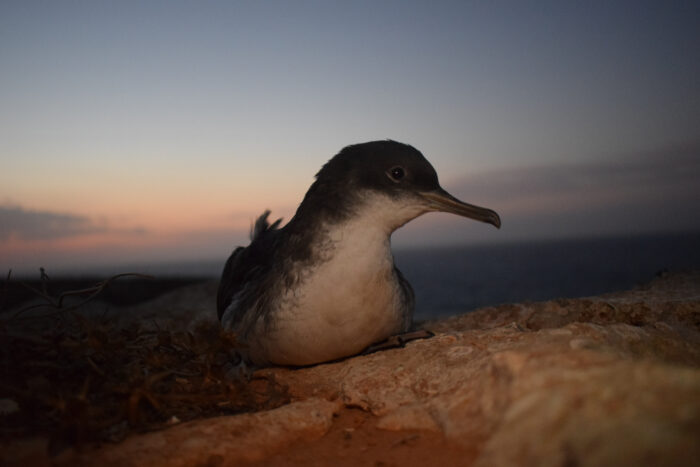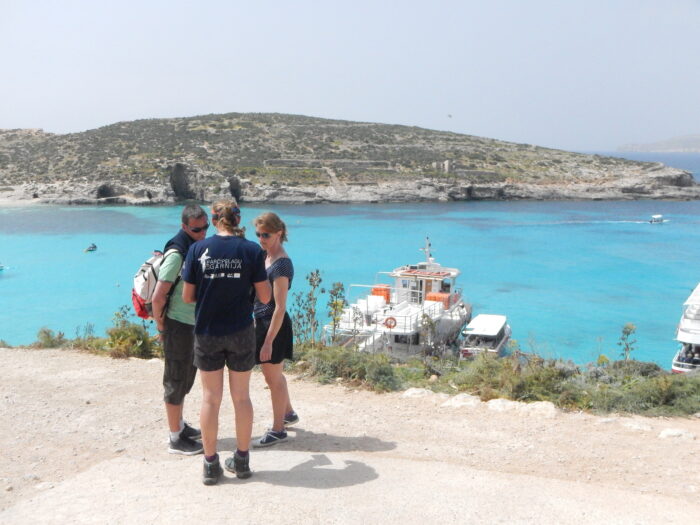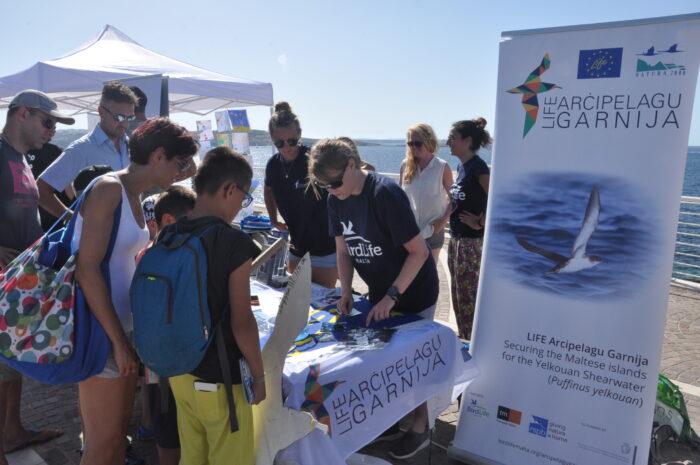This month marks the end of another successful seabird project for BirdLife Malta – LIFE Arċipelagu Garnija. After five years of hard work it’s time to look back on the highlights of what the LIFE Arċipelagu Garnija team have achieved, and what’s next.
Getting started
The LIFE Arċipelagu Garnija project started in 2015 with the focus on a long-term recovery of the Yelkouan Shearwater (Puffinus yelkouan) in Malta while boosting previous LIFE project conservation efforts. Yelkouans are endemic seabirds to the Mediterranean and are categorised as Vulnerable (one of the endangered categories) on the International Union for Conservation of Nature (IUCN)’s Red List of Endangered Species due to their reducing population. As 10% of the global population of Yelkouan Shearwaters breed in Malta, protecting them in Malta is important to sustain their global population.
Although the location of most breeding colonies was already known from previous seabird monitoring, there was still a need for more detailed information, in particular assessment of the site-specific threats. With the knowledge about the number of breeding pairs and reproductive output, conservation actions aimed at securing the breeding sites from direct and indirect threats could develop.
Significant research effort through lots of fieldwork combining different methods and technologies provided the team with a unique understanding of each colony and how to manage the threats at these colonies. These initial assessments gave us baseline data for continued monitoring for the rest of the project and beyond. We were immediately able to identify low breeding success due to the presence of rats at most breeding colonies across Malta. This issue continued to be one of the biggest threats as rats can eat the Yelkouan eggs and chicks, which is especially problematic due to Yelkouan pairs only producing one offspring a year. Light pollution, boat disturbance and disturbance of the sites by people were also identified as prevalent threats across many breeding colonies.
Conservation success: Rat control
Suppressing the rat populations at colony sites (rat control) became a main priority for conservation action due to many of the Yelkouan colonies being affected by rat predation. Checks to monitor for rat presence have been regularly carried out, and where rats were present, seasonal eradication has been a large part of the fieldwork. Eradicating the rats completely was found to be unsustainable according to a feasibility study on Comino, carried out by the project partner, the Royal Society for the Protection of Birds (RSPB), due to the high volumes of boat tourism as a source of rat invasions on the island. However, seasonal eradication from February to July (to cover the whole Yelkouan Shearwater breeding season) was carried out with around 250 bait stations over six cliff and islet sites across the Maltese Islands, resulting in saving many Yelkouan chicks each year.
Policy success: Tackling light pollution
Mitigating light pollution has also been a large part of the project and although it’s been a steep learning curve we have had a lot of success. This part of the project aimed to understand the mechanisms and impact of light pollution, and tackle the problem through policy. Light pollution can disorientate seabirds as they are adapted to coming into their nests at night, and fledglings leaving their cliff nests for the first time can get confused and end up stranded inland instead of flying out to sea. We focused on both permanent light pollution from coastal development, and temporary light pollution from maritime activities such as bunkering of ships. We started with long-term monitoring data of grounded seabirds (collected by BirdLife Malta through public engagement and volunteers since the 1980s) and our own light intensity measurements at Yelkouan Shearwater colony sites to identify the scale of the problem and the sources of light pollution.
To understand the complexity of the mitigation process, we implemented a pilot project at Ċirkewwa Ferry Terminal (a light pollution source near three Yelkouan colonies) in partnership with Transport Malta. After initial light intensity measurements, we ran models of possible lighting alternatives factoring in logistics and needs of stakeholders and partners to come up with possible solutions. Once these seabird-friendly alternatives are implemented at Ċirkewwa Ferry Terminal, we will not only reduce the light pollution at three Yelkouan Shearwater colonies, but also have a solid example of light pollution mitigation in Malta.
We also carried out policy reviews on light pollution and met with all actors involved in lighting in Malta (both local and national authorities) to understand the roles and responsibilities of different authorities and to identify the gaps in policy. We now have a good understanding of how we need to tackle light pollution in Malta going forward, including engaging the public to inform and gain support in light pollution campaigns. Some successes include the #savedwejra campaign which we achieved with the help of public support, as well as reducing light pollution at specific areas such as Għar Lapsi, Wied iż-Żurrieq, Qortin Army Base, Torri ta’ Xutu, and Qammiegħ. We have also submitted our policy recommendations to the Ministry for the Environment which we hope will be adopted into national policy and also recently published Guidelines for Ecologically Responsible Lighting.
Public awareness success: Reducing disturbance
Reducing disturbance from site users and maritime activities has been a focus of our conservation and public awareness actions. We have implemented various outreach campaigns in the areas of breeding colonies targeting site-users including boat owners, fishers, tourists, and private companies such as cafes and restaurants. Multiple outreach and communication methods were used – events, lectures, talks with site-users, leafleting, putting up information boards, etc. We carried out questionnaire surveys onsite and telephone surveys to measure the effectiveness of our outreach. Our survey results showed that there has been a positive impact of our outreach, especially in terms of awareness increase regarding the threats of rat predation and light pollution to seabirds.
Following comprehensive surveys in the first two years of the project, we have also proposed guidelines to regulate the boat-based tourism at certain sensitive sites and reduce the disturbance to the breeding Yelkouan Shearwaters. These proposals were discussed and finalised with Transport Malta and consulted with the commercial boat operators before being published as Notice to Mariners. We are currently working in collaboration with Transport Malta to implement the guidelines for commercial vessels, and our after-LIFE plan will be to increase the focus on more collaboration with mariners and the introduction of ecotourism in boat-based tourism in Malta.
Concluding the project
During the LIFE Arċipelagu Garnija project we have been able to monitor the Yelkouan Shearwater populations and increased breeding success through our conservation actions. After handling almost 1,500 individual adults (1,050 of which we ringed for the first time) and over 500 chicks, as well as analysing thousands of camera trap and thermal images and lots of hard work in the field, our estimated population of the Yelkouan Shearwater in Malta has increased from 1,370-2,000 to 1,795-2,635 breeding pairs (with this year’s population data still being analysed). Our conservation actions ensured an average increase in breeding success, especially thanks to rat control. Once this year’s data has been fully analysed we will be publishing a final report and look forward to sharing our final data.
We would like to thank all our staff and volunteers that have been involved in the project for their dedication and hard work to make this project such a success. And of course, we would also like to extend our thanks to all our partners that have worked with us and supported us throughout the project, as without these partnerships and without working with such a wide variety of stakeholders, our conservation achievements would not have been possible.
Although the LIFE Arċipelagu Garnija project is coming to a close, seabird conservation projects in Malta will be continuing under a new project: LIFE PanPuffinus! This will be BirdLife Malta’s fourth EU-LIFE project focused on seabirds, implemented in collaboration with other seabird researchers in Portugal, Spain, France and Greece. This project will continue with the important predator management and biosecurity work on the Maltese Islands to ensure that Yelkouans are raising their chicks successfully, as well as focusing on working with fisheries to understand the scale of incidental capture in fishing gear as a threat to seabirds and possible mitigation.
We look forward to starting this new phase at the end of this year and continuing to work with our amazing and beloved Mediterranean seabirds!
By Hannah Pepe, BirdLife Malta Nature Reserves & Seabird Conservation Assistant
Hannah Pepe is an Erasmus+ volunteer following a European Solidarity Corps programme





